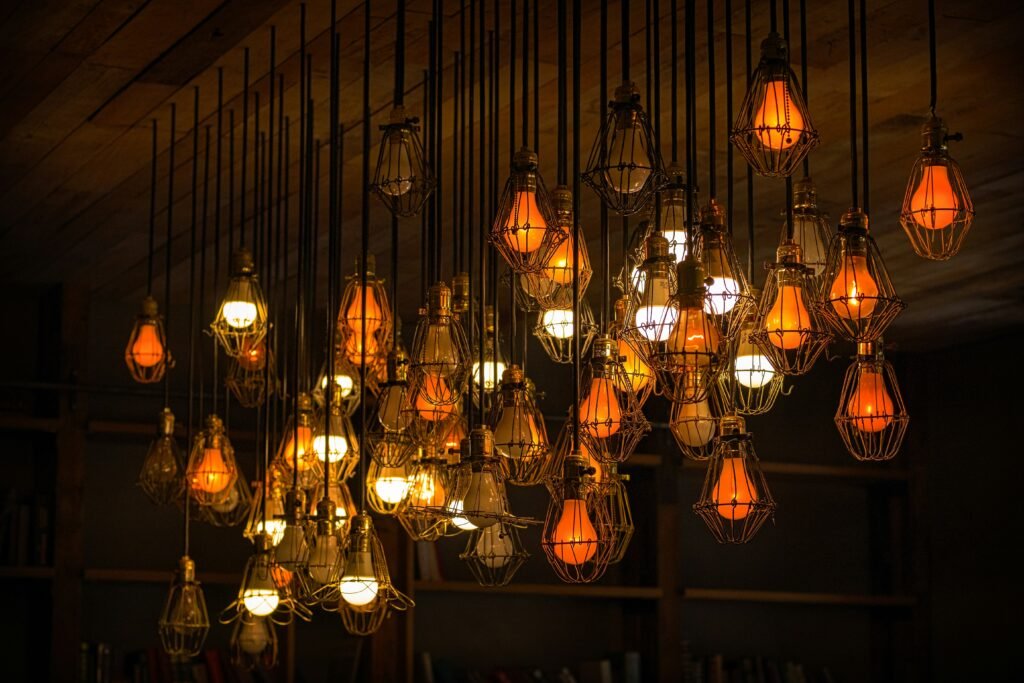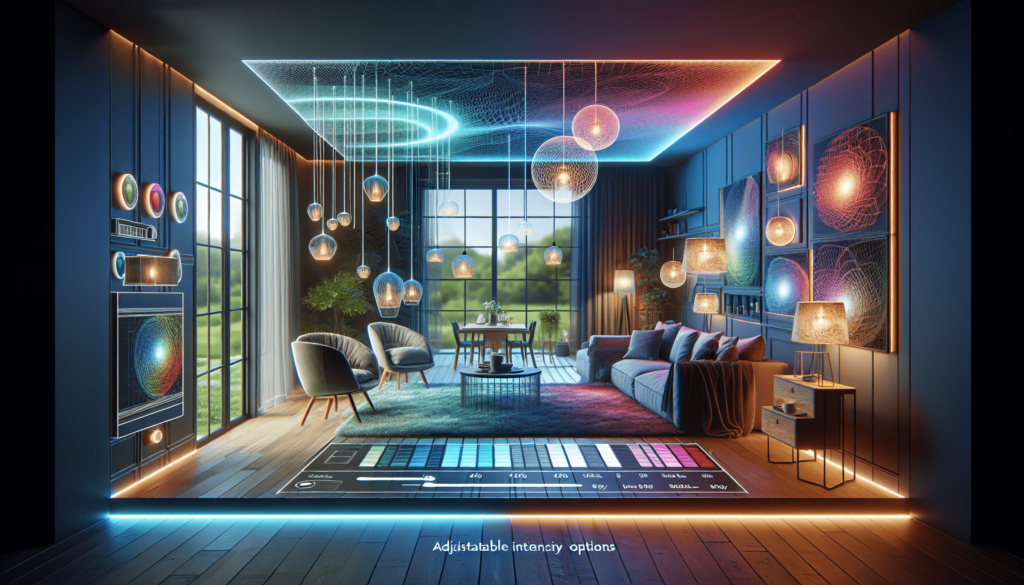Imagine being able to completely transform the atmosphere of your space with just a flick of a switch. With multifunctional lighting, this dream becomes a reality. From providing bright task lighting to creating a cozy ambiance, multifunctional lighting ideas have the power to revolutionize your home or office. Whether you want to maximize productivity, enhance relaxation, or create a warm and inviting environment, multifunctional lighting offers endless possibilities to cater to your needs and preferences. Say goodbye to dull and monotonous lighting and say hello to a world of versatility and creativity. Get ready to transform your space and elevate your experience with the magic of multifunctional lighting.
Task Lighting
Task lighting for improved functionality
Task lighting refers to a specific type of lighting that is designed to illuminate a particular area or surface where specific tasks are performed. It plays a crucial role in providing adequate lighting for tasks such as reading, cooking, or working on a desk. By focusing light on the task at hand, it enhances functionality and reduces eye strain.
Examples of task lighting fixtures
There are various fixtures available that are suitable for task lighting. Some popular examples include desk lamps, under-cabinet lights in kitchens, pendant lights above work surfaces, and adjustable floor lamps with directional light. These fixtures offer focused illumination, ensuring that you have the right amount of light in the areas where you need it most.
Choosing the right task lighting for your space
When selecting task lighting for your space, it’s essential to consider factors such as the size of the area, the specific task requirements, and the overall design aesthetic. Opt for fixtures that provide ample light without causing glare or shadows. Additionally, choose lighting fixtures that complement the existing decor in your space to create a cohesive and visually pleasing environment.
Ambient Lighting
Creating a warm and inviting atmosphere with ambient lighting
Ambient lighting, also known as general lighting, provides overall illumination to a room. It sets the tone and creates a welcoming and cozy atmosphere. Unlike task lighting, ambient lighting is not intended to focus on specific tasks but rather to provide a comfortable level of brightness throughout the entire space.
Different types of ambient lighting
There are several options for ambient lighting, including recessed lighting, ceiling-mounted fixtures, wall sconces, and chandeliers. Each of these fixtures emits a diffused, soft light that fills the space evenly without causing harsh shadows or bright spots.
Strategies for incorporating ambient lighting into your space
To effectively incorporate ambient lighting into your space, it’s important to consider the size and layout of the room. For larger areas, multiple sources of ambient lighting, such as a combination of recessed lights and a central ceiling fixture, can be used to evenly distribute the light. In smaller rooms, a single central fixture or wall sconces can provide sufficient ambient lighting. Additionally, using dimmers can help customize the level of brightness and create a more intimate ambiance when desired.

Accent Lighting
Adding drama and visual interest with accent lighting
Accent lighting is used to highlight specific areas, objects, or architectural features in a room. It adds depth, drama, and visual interest to your space by drawing attention to focal points, artwork, or decorative elements.
Key areas to highlight with accent lighting
There are several focal points in a room that can benefit from accent lighting. These include artwork on walls, sculptures, architectural details like arches or columns, and even indoor plants. By strategically placing accent lights, you can create impressive lighting effects and bring attention to these features, elevating the overall aesthetic appeal of your space.
Types of fixtures suitable for accent lighting
There are various fixtures that work well for accent lighting. Track lighting with adjustable spotlights allows you to direct light precisely where you want it. Wall-mounted picture lights are ideal for illuminating artwork. Recessed lighting with a narrow beam angle can be used to highlight specific objects or architectural elements. Additionally, uplights positioned on the floor can create a dramatic effect by casting light upwards onto walls or ceilings.
Adjustable Lighting
Flexible lighting options for versatile spaces
Adjustable lighting fixtures offer the flexibility to adapt to different lighting needs in a space. They allow you to control the direction and intensity of light, making them ideal for versatile areas that serve multiple purposes.
Benefits of adjustable lighting
The main advantage of adjustable lighting is that it allows you to customize the illumination based on specific activities or moods. Whether you need focused light for reading or a softer, more diffused glow for relaxation, adjustable fixtures can easily cater to your needs. Additionally, by adjusting the direction of light, you can minimize glare and shadows, enhancing the overall comfort and functionality of your space.
Examples of adjustable lighting fixtures
Some examples of adjustable lighting fixtures include track lighting with movable heads, adjustable spotlight fixtures, swing-arm wall sconces, and floor lamps with adjustable arms or shades. These fixtures provide you with the ability to direct light precisely where you need it, making them a versatile choice for any space.

Dimmable Lighting
Creating ambiance and controlling brightness with dimmable lighting
Dimmable lighting offers the ability to adjust the brightness levels of your lighting fixtures. It allows you to create different moods and ambiance, whether you prefer a well-lit environment for productivity or a softer, more relaxed atmosphere for winding down.
Advantages of dimmable lighting
One of the main advantages of dimmable lighting is the ability to save energy by reducing the overall light output. By dimming the lights, you can lower your electricity consumption and ultimately save on utility costs. Dimmable lighting also provides flexibility in creating the desired ambiance for different occasions, allowing you to set the perfect mood for any activity.
Popular dimmable lighting options
There are various dimmable lighting options available, including dimmable LED light bulbs, dimmable recessed lighting, and dimmable wall sconces. Make sure to check the compatibility of your existing fixtures with dimmer switches or consider upgrading to dimmer-compatible fixtures. Dimming systems can be controlled through traditional wall switches, remote controls, or smart home automation systems, providing convenience and ease of use.
Smart Lighting
Integrating technology for customizable lighting solutions
Smart lighting refers to lighting systems that can be controlled remotely through connected devices such as smartphones, tablets, or voice assistants. It allows you to tailor and automate your lighting according to your preferences and lifestyle.
Features and benefits of smart lighting
Smart lighting offers various features that go beyond traditional lighting solutions. You can control the brightness, color temperature, and even the color of your lights with just a few taps on your device. Some systems also offer scheduling options, allowing you to program your lights to turn on or off at specific times. Additionally, smart lighting can be integrated into smart home ecosystems, enabling seamless control and automation of your entire lighting system.
Top smart lighting brands and products
There are several reputable brands that offer smart lighting solutions, including Philips Hue, Lutron, and Nanoleaf. These brands provide a wide range of products, from smart light bulbs and LED strips to complete lighting systems. Each brand offers its own unique features and compatibility with different smart home platforms, allowing you to choose the system that best suits your needs and preferences.

Multi-directional Lighting
Maximizing light coverage with multi-directional fixtures
Multi-directional lighting fixtures are designed to emit light in multiple directions, ensuring even coverage across the entire space. They are particularly useful in rooms with high ceilings or areas that require uniform illumination.
Efficiently illuminating large spaces
In large spaces, such as living rooms or open-concept areas, multi-directional lighting can effectively illuminate the entire area. By dispersing light in different directions, these fixtures eliminate dark corners and provide consistent brightness throughout the room. They can also be useful in commercial settings, such as retail stores or offices, where maximizing light coverage is essential.
Popular multi-directional lighting designs
Some popular multi-directional lighting designs include recessed lighting with adjustable trims, track lighting systems with movable heads, and pendant lights with multiple light sources. These fixtures allow you to control the direction and angle of light, enabling you to customize the illumination according to your specific needs and preferences.
Space-saving Lighting
Innovative lighting solutions for compact areas
Space-saving lighting offers creative solutions for areas with limited square footage. These fixtures are designed to be visually unobtrusive while providing adequate lighting, making them ideal for small rooms, apartments, or areas where space is a premium.
Examples of space-saving lighting fixtures
There are numerous space-saving lighting options to choose from. Wall sconces, for instance, can free up valuable floor or tabletop space while still providing ample illumination. Pendant lights with compact designs can be hung above dining tables or kitchen islands without overwhelming the space. Additionally, recessed lighting is an excellent choice for areas with low ceilings, as it stays flush with the ceiling, maximizing vertical space.
Tips for optimizing space with lighting
To optimize space with lighting, consider the scale and proportion of the fixtures in relation to the room. Choose fixtures that are visually lightweight and don’t overpower the area. Utilize vertical spaces by incorporating wall-mounted or pendant lighting instead of bulky freestanding lamps. Additionally, consider lighting fixtures that serve multiple functions, such as those with built-in storage or shelving, to maximize the utility of the space.

Decorative Lighting
Adding aesthetic appeal with decorative lighting
Decorative lighting serves both practical and aesthetic purposes. It adds character, charm, and visual interest to your space while providing functional illumination. By selecting the right decorative lighting fixtures, you can transform your room into a visually captivating environment.
Trends in decorative lighting
There are several trends in decorative lighting that can inspire your design choices. For example, the use of statement chandeliers or pendant lights with unique shapes or materials can create a focal point in a room. Industrial-inspired fixtures, such as exposed bulb pendants or pipe-shaped floor lamps, are also popular choices for adding a modern, edgy look. Additionally, incorporating eco-friendly materials like bamboo or recycled glass into decorative lighting fixtures is a growing trend for those seeking sustainable design options.
Creative ways to incorporate decorative lighting
There are endless creative ways to incorporate decorative lighting into your space. Hang a cluster of pendant lights at different heights to create a striking visual display. Use wall sconces to highlight artwork or create a cozy reading nook. Install string lights or fairy lights to add a whimsical touch to your outdoor space. With decorative lighting, the possibilities are countless, allowing you to truly personalize your space.
Energy-efficient Lighting
Reducing energy consumption and lowering utility costs
Energy-efficient lighting is not only environmentally friendly but also helps reduce energy consumption and lower utility costs. With advancements in lighting technology, there is a wide selection of energy-efficient options available that can help minimize your carbon footprint.
Energy-efficient lighting technologies
LED (Light Emitting Diode) lighting is one of the most energy-efficient options available today. LED bulbs use significantly less energy than traditional incandescent bulbs, causing them to last longer and generate less heat. Compact Fluorescent Lamps (CFLs) are also energy-efficient alternatives, providing cost savings and reducing greenhouse gas emissions.
How to choose energy-efficient lighting options
When choosing energy-efficient lighting options, look for fixtures with the ENERGY STAR label. ENERGY STAR-certified products meet strict energy efficiency guidelines set by the U.S. Environmental Protection Agency (EPA). Additionally, consider the color temperature and light output of the bulbs or fixtures to ensure they meet your desired lighting needs. By investing in energy-efficient lighting, you can not only save on electricity bills but also contribute to a greener and more sustainable future.
By implementing the various types of lighting discussed in this article, you can transform your space into a well-lit, functional, and visually appealing environment. Whether you prioritize task lighting for specific activities, ambient lighting for overall comfort, or accent lighting for aesthetic enhancement, there are lighting options available to suit your needs. By considering factors such as flexibility, energy efficiency, and personal style, you can select the ideal lighting solutions that will truly enhance your space. So, go ahead and explore the vast world of multifunctional lighting ideas to create the perfect ambiance in your home or workplace.



